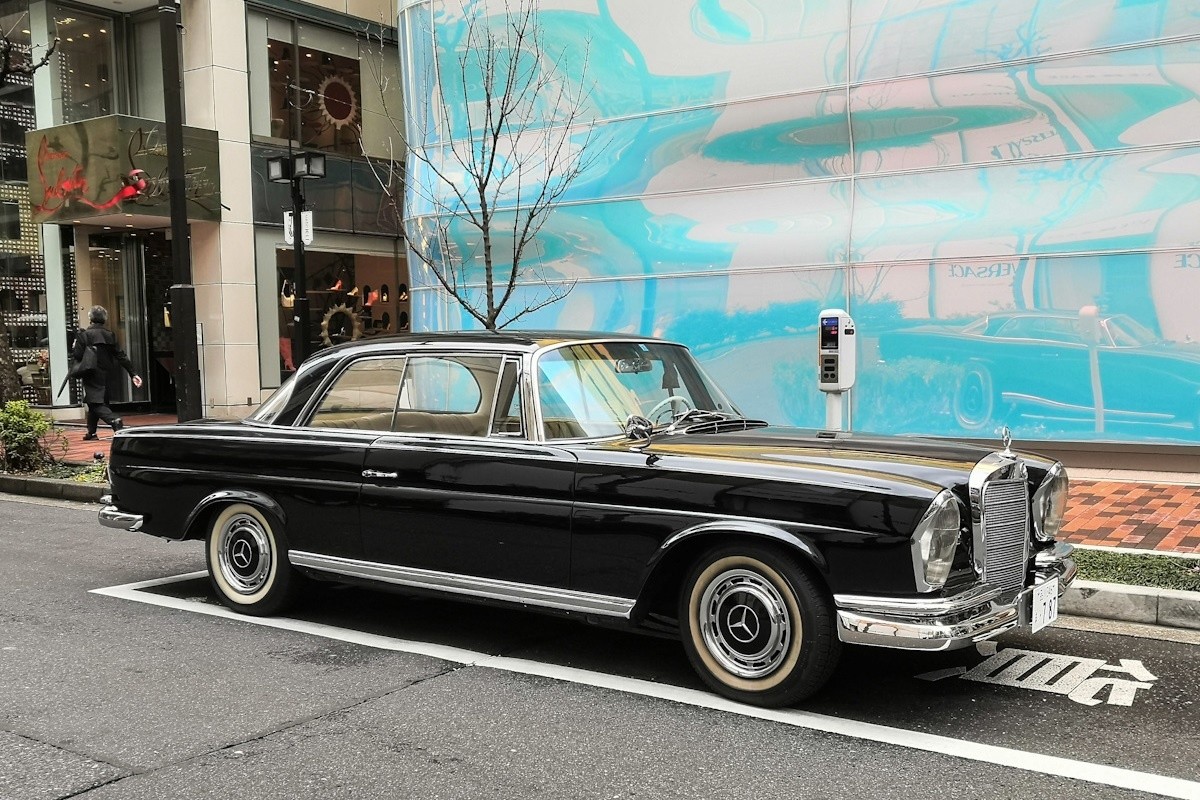The Mercedes-Benz W111 series, a true icon of automotive design and luxury, continues to captivate enthusiasts worldwide. While words often fall short in truly capturing the essence of this classic beauty, let’s delve into what makes the W111 Mercedes-Benz coupé such an enduring symbol of automotive excellence. Much like spotting a rare gem on the streets of Tokyo, encountering a W111, especially one as meticulously maintained as the black model featured here, is a moment to be savored. This particular model, with its early design cues, European headlights, and desirable manual transmission, embodies the spirit of a bygone era of automotive craftsmanship.
The allure of the W111 Mercedes-Benz is undeniably amplified when cloaked in black. This color choice accentuates the car’s inherent sophistication, lending it a subtly imposing presence reminiscent of Cold War-era Berlin’s understated power and elegance. Regardless of the W111’s body style – whether coupé, sedan, or cabriolet – black paintwork enhances its timeless design, creating an air of mystery and prestige.
The atmospheric conditions of a grey winter day, like the one in 2022 when these photographs were taken, only serve to deepen the W111’s mystique. The muted light emphasizes the car’s form and the impeccable detailing that is characteristic of vehicles in Tokyo, where automotive care and presentation are elevated to an art form.
The mirror-like finish of this W111 Mercedes-Benz speaks volumes about the dedication to preservation and maintenance it has received. Every surface reflects a commitment to automotive excellence, a hallmark of both the Mercedes-Benz brand and the culture of car enthusiasts in Japan.
The W111 220 SE Coupé: A Pioneer of its Time
The specific model showcased here is the 220 SE Coupé, produced from February 1961 to August 1965. This variant holds a significant place in the W111 lineage as the launch model for the two-door design penned by the legendary Paul Bracq. Bracq’s masterful touch gave the W111 coupé its distinctive “fintail” styling, a subtle nod to American automotive trends while maintaining a distinctly European elegance.
Commercially, the 220 SE Coupé was the most successful within the W111/112 two-door range. Over 14,000 units were manufactured, surpassing all other two-door iterations including the hardtop and cabriolet versions of the 220 SE, 250 SE, 280 SE, 300 SE, and the later V8-powered 280 SE 3.5 models produced between 1961 and 1971. This success underscores the 220 SE Coupé’s broad appeal and timeless design.
Performance and Practicality
While the 220 SE Coupé boasted sophisticated styling, it was also the least powerful of the W111 two-door models, producing around 118 horsepower. The featured model’s manual transmission, however, offers a more engaging driving experience, though the aftermarket air conditioning system likely draws some power from the engine.
The rear seating in the W111 coupé is compact, making it ideally suited for children or shorter journeys. Despite its limitations in rear passenger space, the overall elegance and driving experience of the W111 coupé more than compensate.
The Quintessential Mercedes-Benz Face
For many, the face of the W111 Mercedes-Benz embodies the quintessential Mercedes-Benz aesthetic. The commanding grille, generous chrome accents, and vertically oriented headlights are harmoniously integrated, creating a design that is both imposing and perfectly balanced. This front-end design is instantly recognizable and remains a benchmark for Mercedes-Benz styling.
The rear of the W111 is equally understated yet sophisticated. The subtle tailfins, a defining feature of the “Heckflosse” (fintail) Mercedes, add a touch of mid-century flair without being overly flamboyant. This restrained elegance is a hallmark of the W111’s design.
In conclusion, the W111 Mercedes-Benz, particularly in the form of the 220 SE Coupé, represents a pinnacle of automotive design and engineering from the 1960s. Its timeless styling, luxurious appointments, and the sheer presence it commands on the road ensure its continued admiration among classic car aficionados. This black example, captured in the heart of Tokyo, stands as a testament to the enduring appeal and perfection of the W111 Mercedes-Benz.

